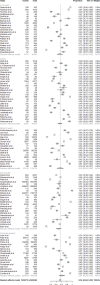Micronutrient's deficiency in India: a systematic review and meta-analysis
- PMID: 35059191
- PMCID: PMC8727714
- DOI: 10.1017/jns.2021.102
Micronutrient's deficiency in India: a systematic review and meta-analysis
Abstract
India is coming to grips with a stage of nutrition transition. According to the Food Safety and Standards Authority of India (FSSAI), preventable micronutrient deficiency is arising public health precedence in India. However, the foremost public health concern is the lack of national prevalence data. The present study was carried out to estimate the pooled age-wise prevalence of six preventable micronutrient deficiencies (vitamin A, vitamin B12, vitamin D, iron, iodine and folic acid) in India. A systematic review was carried out on PubMed and Global Index Medicus databases using the Boolean search strategy. Statistical analyses were done using R software, version 3.6. 2. PRISMA guidelines were strictly adhered to during the review. A preliminary literature search yielded 4302 articles; however, 270 original research articles were found eligible to be included in quantitative synthesis. The estimated overall prevalence was 17 % [95 % confidence interval (CI) 0⋅07, 0⋅26] for iodine deficiency, 37 % (95 % CI 0⋅27, 0⋅46) for folic acid deficiency, 54 % (95 % CI 0⋅49, 0⋅59) for iron deficiency, 53 % (95 % CI 0⋅41, 0⋅64) for vitamin B12 deficiency, 19 % (95 % CI 0⋅09, 0⋅29) for vitamin A deficiency and 61 % (95 % CI 0⋅07, 0⋅26) for vitamin D with high heterogeneity. We classified the population into infants (0-5 years), adolescents (<18 years), adults (>18 years) and pregnant women. Iron deficiency was most prevalent (61 %) in pregnant women. The results of the present study reinforce the data on micronutrient deficiency in India and warrant the immediate need for further active public health interventions to address these deficiencies. The study is registered with PROSPERO (CRD42020205043).
Keywords: CI, confidence interval; IDD, iodine deficiency disorders; Iodine deficiency; Iron deficiency; Meta-analysis; Micronutrient deficiency; NFHS, National Family Health Survey; VAD, vitamin A deficiency; VDD, vitamin D deficiency; Vitamin A deficiency; Vitamin B12 deficiency; Vitamin D deficiency; WHO, World Health Organization.
© The Author(s) 2021.
Figures







References
-
- World Health Organization (2021) Micronutrients. https://www.who.int/health-topics/micronutrients (accessed February 2021).
-
- World Health Organization (2021) Malnutrition. https://www.who.int/news-room/fact-sheets/detail/malnutrition (accessed February 2021).
-
- Institute of Medicine (US) Committee on Micronutrient Deficiencies (1998) Summary. Prevention of Micronutrient Deficiencies: Tools for Policymakers and Public Health Workers. [CP Howson, ET Kennedy and A Horwitz, editors]. Washington, DC: National Academies Press, p. 1. - PubMed
-
- World Health Organization (2009) Global prevalence of vitamin A deficiency in populations at risk 1995–2005. WHO Global Database on Vitamin A Deficiency. http://whqlibdoc.who.int/publications/2009/9789241598019_eng.pdf (accessed February 2021).
-
- World Health Organization (2002) Reducing Risks, Promoting Healthy Life: In the World Health Report 2002. Technical Report. Geneva, Switzerland: World Health Organization.
Publication types
MeSH terms
Substances
LinkOut - more resources
Full Text Sources

